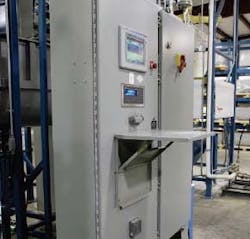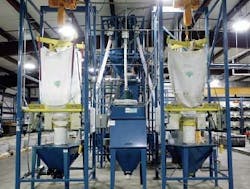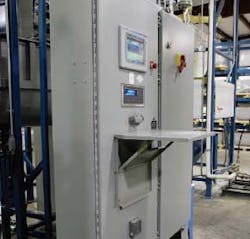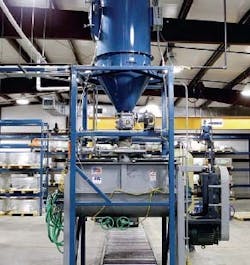The company’s proprietary process involves mixing five dried products. Four of them are received in bulk bags and one in 50-lb. bags. The ingredients are fine powders, relatively free-flowing, dry and dusty. Humidity in the system must be controlled to avoid absorption of room moisture by the dry feed.
Two of the ingredients go directly to a wet blender, while the other three ingredients are routed first to a dry blender for mixing and then to the wet blender. Ingredient weights for the batch recipe vary from a minimum of less than 20 lbs. to a maximum of nearly 400 lbs. in each batch. The process demands that accuracies must be within ±1.00% of target over this broad range of ingredient weights, as well as for the water added for mixing.
After discussions with several equipment vendors and a bidding process, EaglePicher ultimately chose a one-of-a-kind design from Flexicon that combines flexible screw conveyors and a weigh batching center with vacuum pneumatic conveying downstream to feed the blend tank and that provides an efficient use of floor space for the batch process.
Flexible screw conveyors were selected because they can achieve the required accuracy easier than other technology. The combination of flexible screws and pneumatic conveyors was the most economical choice, offering not just lower initial cost but also the need for less maintenance.
Design requirements
The process demanded bulk bag unloading equipment and a weigh-batching system with powder conveying. Flexicon proposed a common gain-in-weight batching center using flexible screw conveyors to move the ingredients from the bag unloading hoppers and pneumatic conveying to move the weighed ingredients to the proper destination. Figure 1 shows the overall system schematic.
Figure 1. The combination of flexible screw conveyors and a vacuum pneumatic conveyor provides a reliable and accurate weigh-batching system.
Bulk bags are unloaded with cantilevered I-beam bag unloaders equipped with electric hoists and trolleys, eliminating the need for a forklift. The bulk bag dischargers are part of a sealed system that contains dust and promotes the flow and total evacuation of material (Figure 2).
Figure 2. The unloaders use a proprietary bag-spout interface that creates an integral seal.
The fifth, minor ingredient is manually unloaded into a bag dump station with dust collection. The operator dumps several bags at a time into the hopper, filling it with about a week’s worth of the material.
The ingredients are transferred via flexible screw conveyors into the weigh batch system (Figure 3).
Figure 3. An accuracy of 1% can be achieved using “dribble speed” on the screw conveyors.
Each of the five screw conveyors is designed specifically for the powder being moved, with different sizes, materials of construction, and screw designs based on each material’s bulk density and flow properties. Flexible screw conveyors are an ideal choice for this type of application, with each material-dedicated conveyor providing high accuracy and reliability with low maintenance.
The single, common gain-in-weight batching system measures ingredients in sequence as they flow into the central weigh hopper (Figure 4).
Figure 4. Operators can manage the entire process according to pre-programmed batch recipes.
Load cells transmit weight gain information to a controller that starts and stops the conveyors, slowing to a dribble feed rate as the weight approaches the target to meet the high accuracy requirements. A slide gate valve at the bottom of the weigh hopper discharges the ingredient.
Because the weighed feed streams go to two different destinations, either the dry blender or the wet blender, a specially designed wye diverter valve sends each ingredient to the proper place. The first two ingredients bypass the dry blender located just below the weigh batching system and drop through a rotary airlock valve into the vacuum pneumatic conveying system that takes them to the wet blender. There they are pre-mixed with water and given time to blend. The other three ingredients drop through the diverter valve directly into the dry blender where they are mixed for 30 minutes. The blended mixture is then discharged from the bottom of the dry mixer through the same rotary airlock valve; the pneumatic conveyor transfers the mixture to the wet blender.
A vacuum pneumatic conveying system was selected because of its ability to handle the diverse range of powders with differing characteristics and because the dust poses a hazard if it escapes. In addition, the system will fully evacuate the vessel being discharged as well as the conveying line itself, so cross-contamination is minimized in this multi-ingredient system. Complete transfer of the material also ensures that accurate amounts of both the individual and consolidated batch ingredients reach their destinations.
As each of the dry ingredients exits the pneumatic conveyor they are collected in a filter-receiver equipped with reverse-pulse jet filter cleaning to dislodge accumulated dust from filter surfaces, assuring complete separation of the material from the vacuum air stream (Figure 5).
Figure 5. A filter-receiver with pulse-jets feeds powder from the vacuum pneumatic conveyor to a wet mixer below.
The filter-receiver hopper utilizes a load cell weigh module to confirm complete batch transfer. Another rotary airlock valve takes the powder directly into the wet blender below. A 20-hp positive-displacement vacuum pump located downstream of the filter-receiver provides sufficient airflow to transfer all the materials.
Commissioning
Flexicon engineers, backed by Osborne Equipment Sales, Inc., Broken Arrow, Okla., were on site during startup for operator training. The integrated conveying package meets all process requirements and prevents contamination of its product and plant environment, according to Loren Harding, EaglePicher’s manager of operations.
Eagle Picher’s ultimate choice of Flexicon was based on several important advantages. “Flexicon had the weighing and batching experience to supply a unique integrated turnkey system, including PLC-based controls, with guaranteed accuracies. Furthermore, Flexicon’s bulk bag discharger, with patented bag-spout interface, was the best we encountered for maintaining a sealed system during unloading,” says Harding. “Finally, and perhaps most importantly, Flexicon was the only company to propose a vacuum pneumatic system combined with mechanical conveying, the most advantageous solution for our requirements,” he adds.
David Boger is sales manager for Flexicon Corporation in Bethlehem, Pa.; e-mail him at [email protected].





